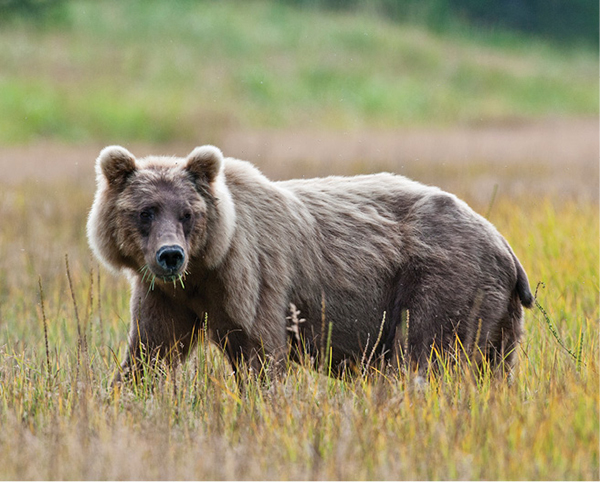
A grizzly bear female won’t become pregnant unless she has enough physical reserves for both hibernation and gestation. Photo William Mullins
Pregnancy and Gestation
For most mammals, whether a female becomes pregnant as a result of breeding is determined quickly. If the female’s egg (or eggs) doesn’t become fertilized and attach to the uterine wall shortly after mating, she will not become pregnant. This process, however, is much more complex for grizzly bears. Grizzly bears are one of a number of species (including other bears and animals such as weasels, armadillos, and seals) that become pregnant through a process known as “delayed implantation.” Delayed implantation is an obligatory biological process for some species (such as grizzly bears), meaning it occurs all the time. In other species delayed implantation is a facultative process, referring to the fact that it occurs in response to conditions in a female’s body or the environment.
After mating, fertilized eggs (embryos) float in a grizzly bear’s uterus for a period of time. They remain viable during this interval, but do not absorb the nutrients from the female’s body necessary for growth because they have not yet attached to the wall of the uterus. Sometime in late fall or early winter, about the time the sow enters her den, the embryos she is carrying either attach to the uterine wall, creating a pregnancy, or are simply reabsorbed by her body.
What determines whether a female bear becomes pregnant following the process of delayed implantation? Remember all that food grizzly bears eat in late summer and fall to store fat for hibernation? For female bears that mated earlier in the summer, fat reserves also play a critical role in pregnancy. If her body senses she has sufficient reserves of fat and other nutrients necessary to successfully birth and nurse young, a sow will become pregnant. If not, her embryos will be reabsorbed by her body, delaying pregnancy for at least another year. Although it is a seemingly odd process, evolutionary biologists believe delayed implantation performs a necessary and beneficial function in grizzly bears. Gestation (the process of nourishing an embryo from implantation to birth) and nursing are costly biological processes for grizzly bear sows. By discontinuing a pregnancy when the female has insufficient physical reserves to either gestate or nurse her young, delayed implantation gives a measure of insurance to the reproductive process. In years that a female is in less than optimal body condition, she won’t bear offspring, insulating both herself and her offspring from the risk of malnutrition.
If a female grizzly’s body gives her pregnancy the green light, so to speak, the embryos attach to the uterine wall and begin to develop. Although the time between a female’s mating and the birth of her cubs commonly spans 6 months or more, the actual gestation period is much shorter. From the time the embryo attaches to birth is about 8 weeks.

A grizzly bear female won’t become pregnant unless she has enough physical reserves for both hibernation and gestation. Photo William Mullins